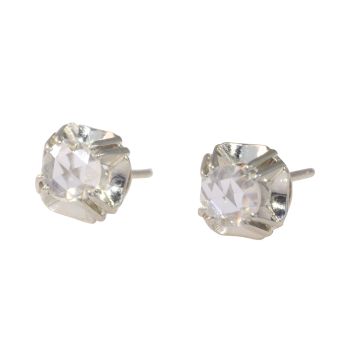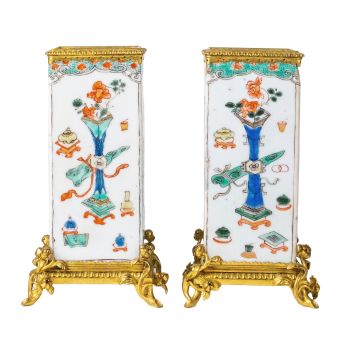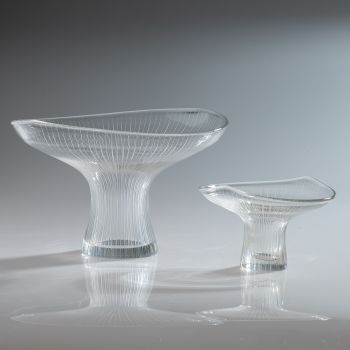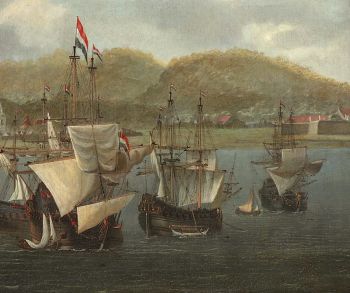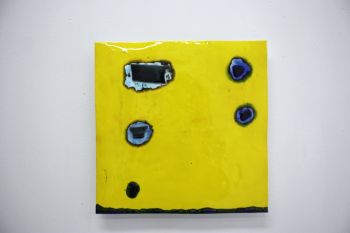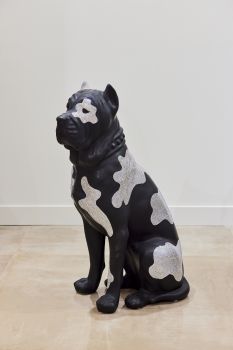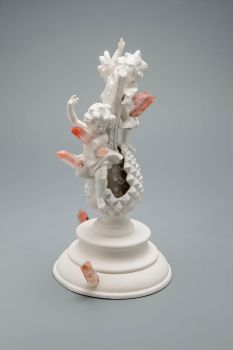GRANDE ESPORTAZIONE ARMATORIALE CINESE PORCELLANA BLU E BIANCA 'VAN DER DOES - STEIN VAN GOLLENESSE' 1755
Artista Sconosciuto
PorcellanaPorcellana cinese
ø 38 cm
Prezzo su richiesta
Zebregs & Röell - Fine Art - Antiques
- A proposito di opere d'arteQianlong period, circa 1755
Blue and white porcelain painted with a double coat of arms beneath a crown to the centre, the rim with three peony sprays between bands of diaper pattern, in the centre, two coats-of-arms.
Diam. 38.4 cm
Note:
On the left are those of Van der Does. They had been born this way by ennobled by King William I since the beginning of the 16th century. The arms on the right are those of the (van) Stein van Gollenesse family. Julius (van) Stein van Gollenesse (1691-1755) was the first to bear these arms in Colombo in 1748. His daughter, Anthonia Dorothea, who married Gerard van der Does, bore these arms on a seal of 1766.
This armorial service was made for Gerard van der Does (Gouda 1732 - Batavia 1758) and Anthonia Dorothea (van) Stein van Gollenesse (Batavia 1740 - Zwolle 1774) on the occasion of their marriage in Batavia on 25 July 1755.
Gerard van der Does belongs to an ancient and prominent family, originally from Croisilles (France) but settled in Holland since about 1320. The family owned the manor house Ter Does near Leiderdorp. In the 15th and 16th centuries, members of the Van der Does family belonged to the patriciate of Delft and Leiden. Later branches with several family members occupied prominent positions in Gouda, Dordrecht, Amsterdam, Gorinchem and ‘s Hertogenbosch. In 1815 this branch was ennobled in the Netherlands. Gerard's father, Adriaan (1686-1749), councillor and alderman in Gouda, and his wife Catharina de Grande (1688-1774) married in 1712 and belonged to the wealthiest inhabitants of Gouda. They had ten children of which Gerard was the youngest. Gerard joined the VOC before 1754 as a junior merchant, then became “Tweede in de Groote Winkel” (second shop keeper), merchant and “Eerste Suppoost van het Comptoir-Generaal”. In 1755 he was appointed alderman of Batavia, but his career was a short one, he died three years later. - A proposito di opere artista
Può succedere che un artista o un creatore sia sconosciuto.
Alcune opere non sono determinate da chi sono state realizzate o sono state realizzate da (un gruppo di) artigiani. Esempi sono statue dell'antichità, mobili, specchi o firme non chiare o leggibili ma anche alcune opere non sono affatto firmate.
Inoltre puoi trovare la seguente descrizione:
•"Attribuito a …." A loro avviso probabilmente opera dell'artista, almeno in parte
•“Studio di ….” o “Officina di” A loro avviso un'opera eseguita nello studio o nella bottega dell'artista, eventualmente sotto la sua supervisione
•“Cerchio di…” A loro avviso un'opera del periodo dell'artista che mostra la sua influenza, strettamente legata all'artista ma non necessariamente al suo allievo
•"Stile di..." o "Seguace di..." A loro avviso un'opera eseguita nello stile dell'artista ma non necessariamente da un allievo; può essere contemporaneo o quasi contemporaneo
•“Modalità di…” A loro avviso un'opera nello stile dell'artista ma di epoca successiva
•"Dopo …." A loro avviso una copia (di qualsiasi data) di un'opera dell'artista
•“Firmato…”, “Datato…” o “Iscritto” A loro avviso l'opera è stata firmata/datata/inscritta dall'artista. L'aggiunta di un punto interrogativo indica un elemento di dubbio
•"Con firma....", "Con data...", "Con iscrizione..." o “Riporta firma/data/iscrizione” a loro avviso la firma/data/iscrizione è stata aggiunta da qualcuno diverso dall'artista
Sei interessato ad acquistare questa opera d'arte?
Artwork details
Related artworks
- 1 - 4 / 12
- 1 - 4 / 12
Gyrinus
Verre gravé pointillé avec putti1764 - 1766
Prezzo su richiestaPeter Korf de Gidts - Antiquairs
1 - 4 / 24Artista Sconosciuto
UN MODELLO GIAPPONESE DI UN NORIMONO, UN PALANQUIN1650 - 1700
Prezzo su richiestaZebregs & Röell - Fine Art - Antiques
Artista Sconosciuto
UN NETSUKE IN AVORIO DI UN OLANDESE CHE TIENE UN GALLETTO18th century
Prezzo su richiestaZebregs & Röell - Fine Art - Antiques
Artista Sconosciuto
COPPIA DI TORCHÈRE O PORTACANDELE IN TEAK INDONESI LACCATI E DORATI18th century
Prezzo su richiestaZebregs & Röell - Fine Art - Antiques
Artista Sconosciuto
A silver spoon commemorating Juff’ Margareta van Hoorn1656 - 1694
Prezzo su richiestaZebregs & Röell - Fine Art - Antiques
Artista Sconosciuto
UN INSOLITO PIATTO D'ARGENTO LOBBATO INDONESIlate 17th
Prezzo su richiestaZebregs & Röell - Fine Art - Antiques
Artista Sconosciuto
A large Japanese Imari porcelain 'VOC Groningen' dish1800 - 1925
Prezzo su richiestaZebregs & Röell - Fine Art - Antiques
Artista Sconosciuto
Olandesi in miniatura18th century
Prezzo su richiestaZebregs & Röell - Fine Art - Antiques
Artista Sconosciuto
Olandesi in miniatura (Netsuke)1700 - 1900
Prezzo su richiestaZebregs & Röell - Fine Art - Antiques
1 - 4 / 24Artista Sconosciuto
Series of 6 Chinese cups and saucers (Yongzheng period)1722 - 1735
Prezzo su richiestaKuipers Kunst & Antiek
Samuel Dejong
Anatomia Blue Heritage, Atlas Closed2017 - 2019
Prezzo su richiestaVilla del Arte Galleries
1 - 4 / 24Artista Sconosciuto
UN MODELLO GIAPPONESE DI UN NORIMONO, UN PALANQUIN1650 - 1700
Prezzo su richiestaZebregs & Röell - Fine Art - Antiques
 A cura di
A cura diDanny Bree
Artista Sconosciuto
A large Japanese Imari porcelain 'VOC Groningen' dish1800 - 1925
Prezzo su richiestaZebregs & Röell - Fine Art - Antiques
1 - 4 / 12









